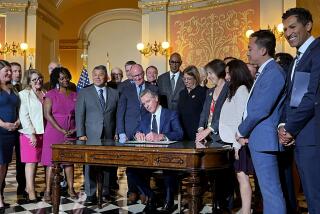Pump Prices Likely to Dip After Labor Day
If the cost of driving seems high, sit tight.
Pump prices have been climbing in advance of Labor Day, as they often do before the last major drive-away weekend of the summer. The average price for self-serve regular in California climbed 4.9 cents to $2.10 a gallon in the week that ended Monday, after having dropped for 12 consecutive weeks, the Energy Information Administration said in its weekly survey.
But after this weekend, when vacations end and demand tails off, retail prices should resume the decline theyâve followed most of the summer.
In fact, the average is expected to dip below the $2-per-gallon mark after Labor Day in California, assuming there isnât a major disruption at refineries in the state, said Bob Van der Valk, the bulk fuels manager at Cosby Oil Co. in Santa Fe Springs.
The reason: Supplies remain ample, thanks to robust gasoline production by refiners this summer and driversâ conservation, analysts said. A recent decline in crude oil prices from record highs, which continued Monday, also bodes well for lower pump prices later this year.
Motorists just have to make it through the holiday weekend.
According to the weekly survey, the average pump price in California recorded its biggest increase since the week that ended May 24, when it rose 5.5 cents to $2.324 a gallon.
âIâve seen an 8-cent differenceâ per gallon in the last week, salesman Mike Botteh said as he paid $2.079 a gallon to fill up Monday at a Shell station in downtown Los Angeles.
Southern Californiaâs lowest-cost gasoline has moved up, too. In Orange County, for instance, the cheapest gas Monday ranged from $1.97 to $1.99 a gallon, compared with $1.90 to $1.92 several days ago, according to CaliforniaGasPrices.com, which tracks fuel costs.
The EIA, an arm of the Energy Department, said the nationwide average slipped 1.8 cents in the latest week, to $1.866 a gallon. The national average is 12 cents a gallon above year-earlier levels, while the California average is the same as it was last year.
Not everyone is convinced prices are headed lower.
âI donât think weâll see them get less than $2 again,â Stephen Washington, a driver for a records storage company, said at the Shell station. âA year from now, weâll be saying: â âRemember when gas was $2.07?â â
Washington said he has had to make trade-offs. As he filled up his companyâs white delivery van, he said he and his wife sometimes asked themselves: âDo we take our daughters to McDonaldâs or do we buy gas for the week?â
California gasoline hit a record average price of $2.327 a gallon in the week that ended May 31. With prices so high, refiners stepped up production despite the parallel increase in prices of crude oil, which typically account for about 45% of gasolineâs per-gallon cost.
That allowed for plentiful gasoline supplies in California and nationwide this summer, enabling retail prices to move down.
On Monday, futures contracts for both gasoline and crude oil fell sharply on the New York Mercantile Exchange. But analysts, noting that many traders were steering clear of New York during the Republican National Convention, said the markets were light and volatile, with relatively few trades accounting for large price swings.
Crude oil for October delivery tumbled 90 cents, or 2.1%, to $42.28 a barrel, despite more sabotage of Iraqâs oil infrastructure. Oil has skidded $6.42 a barrel, or 13.2%, since it closed at $48.70 per 42-gallon barrel on Aug. 19 -- its highest price in the 21 years that the oil contract has traded on the Nymex.
Adjusted for inflation, however, oil prices remain well below the highs they set in 1981 after the Iranian revolution.
Oil prices soared this year because world supplies were tight, demand was rising -- especially in the U.S., China and India -- and traders feared that production might be seriously disrupted by tensions in several parts of the world, notably Iraq.
Those fears became known as the ârisk premiumâ built into prices, which according to some analysts have accounted for $10 to $15 per barrel.
Beginning last week, supply concerns began to abate, said Rick Mueller, senior oil analyst at Energy Security Analysis Inc. in Wakefield, Mass.
âNow the fundamentals of oil are beginning to reassert themselvesâ -- that is, supply and demand forces are again determining oilâs price, he said.
âUnless there is a really dramatic [terrorist] attack that sizably influences oil volumes coming out of the Middle East, weâll probably see prices continue to fall,â Mueller said. âNot as quickly as today, but on that downward slope we saw beginning last week.â
More to Read
Sign up for Essential California
The most important California stories and recommendations in your inbox every morning.
You may occasionally receive promotional content from the Los Angeles Times.











